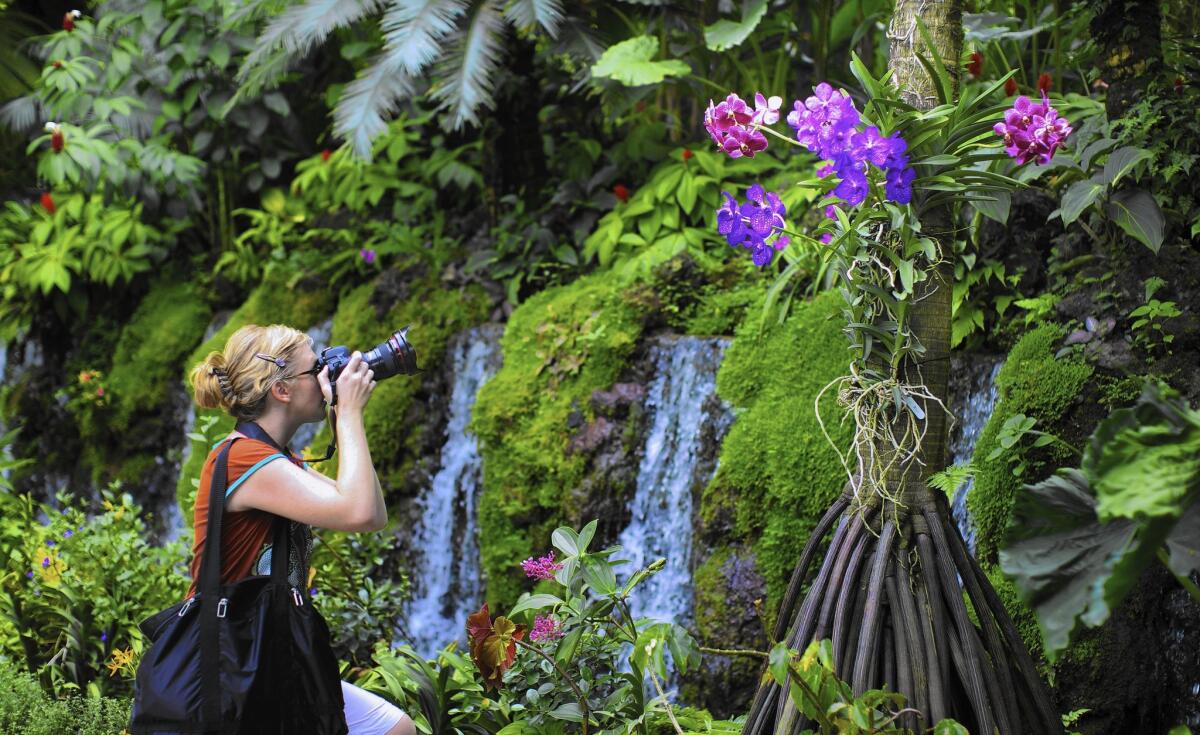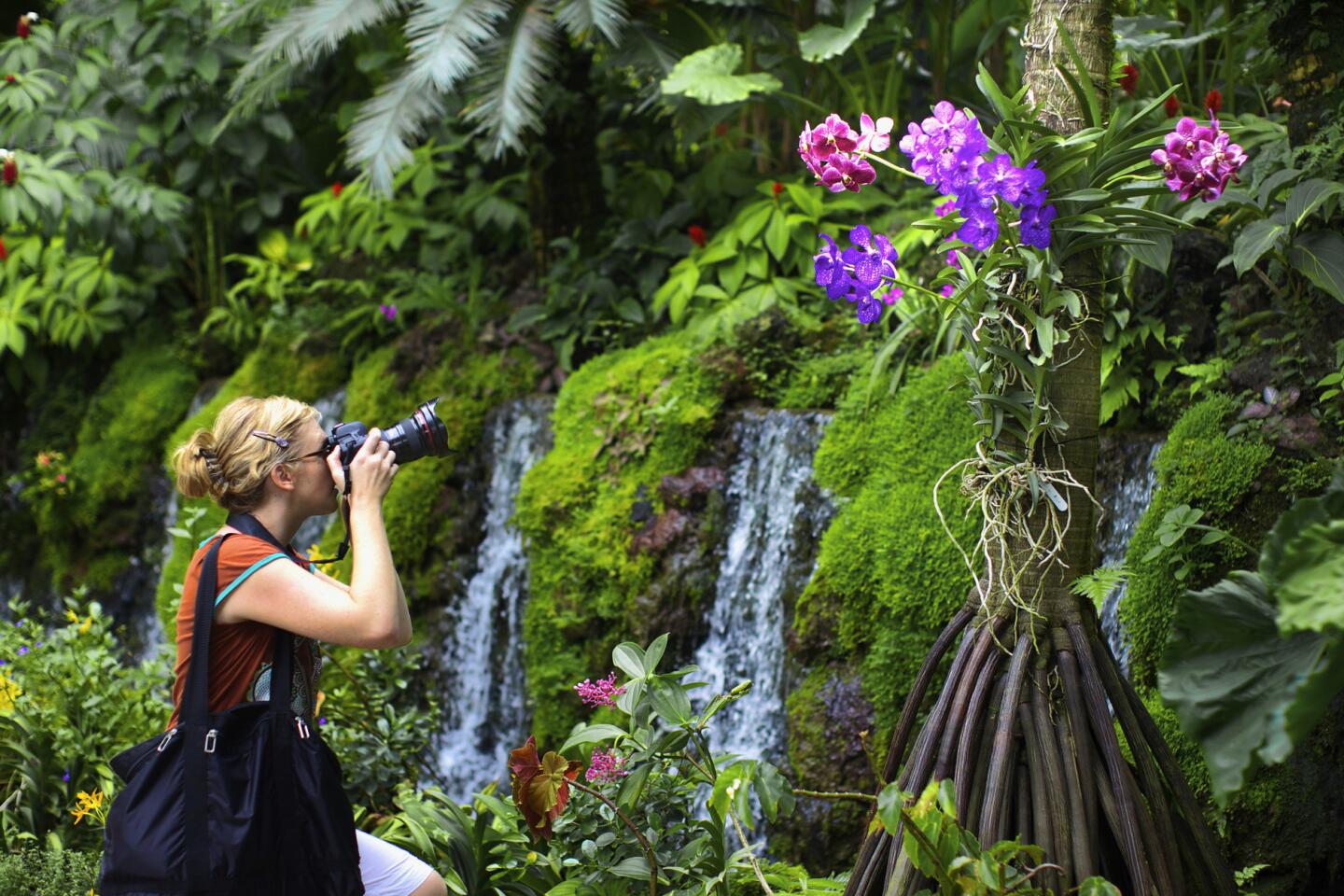Singapore Botanic Gardens colorfully connects people with plants

- Share via
SINGAPORE — If you’ve ever spent time in a tropical greenhouse, you’ll know what strolling through the Singapore Botanic Gardens feels like.
Visually, though, nothing compares to immersing yourself in what Nigel Taylor, its director, describes as “the best and most spectacular of tropical flora.” The garden features more than 10,000 types of plants, including the region’s most notable collection of palms, orchids, cycads and gingers.
As the final stop on an extended tour of Asia in December, I decided to spend Christmas Day in Singapore enjoying a self-guided trek through the city’s 156-year-old botanic gardens.
Here countless flower-lined paths meander beneath leafy canopies leading to such wonders as the Ginger Garden, the Fragrant Garden, the Healing Garden and the Evolution Garden. I could have easily spent a couple of days wandering this 183-acre Eden, which was recently designated a UNESCO World Heritage site, Singapore’s first and the only tropical botanic garden on the list.
I chose, however, its National Orchid Garden, not only because it has the “largest and most comprehensive permanent tropical orchid display in Asia,” Taylor said, but its manageable size would let me focus without the stifling humidity.
Fortunately, I was sufficiently distracted by the tantalizing colors, textures and fragrances to ignore the heat. For all my internalized whining, I did come to appreciate the effect muggy weather has on plant life.
Ideal climate
At just 1.3 degrees north of the equator, the city-state of Singapore has the ideal climate for the planet’s largest and most diverse family of flowering plants. What’s more, Taylor said, “orchids have long been associated with Singapore’s image, due largely to our cut-flower orchid industry, which exports more than 10 million stalks each year.”
It’s no surprise that 1,000 or so varieties thrive at the site, in the heart of Southeast Asia’s most economically developed city.
But Singapore is also a uniquely green city — something immediately apparent when arriving at Changi International Airport. Amid the oversized terminals you’ll encounter rooftop cactus, orchid and sunflower gardens. There’s even a butterfly garden, the first in an airport.
As I passed through the orchid garden’s entry gate I admired the cascading fountain, topped with a sculpture of cranes, and its backdrop of towering palms contrasting with the golden blooms of Dancing Lady orchids. Next was the planet’s largest orchid plant, the Tiger, an epiphyte (a species that attaches itself to trees or other plants) that can support close to 300 flowers on a single plant.
Less impressive but no doubt significant was nearby Burkill Hall, an example of colonial architecture from 1866 — now used for weddings and other functions. Originally, it was the home of Sir Henry Nicholas Ridley, the world-renowned orchidologist who was Singapore Botanic Gardens’ first director from 1888 to 1911.
The idea of creating a national garden began in 1822 when Sir Stamford Raffles, a British statesman known as the “Father of Singapore,” initiated the city’s first botanic garden on the slopes of Fort Canning Hill. It was created to experiment with cultivating nutmeg and clove for their economic value.
The actual botanic gardens were established at their current site in 1859 when the Agri-Horticultural Society acquired a 57-acre plot of land to develop a “pleasure garden.” It was given to the government in 1874. A year later it resumed growing cash crops — again for the British Empire — but this time the focus was on oil palms and rubber trees. In fact, by the early 1900s the gardens played a key role in developing new rubber cultivation approaches that helped expand the region’s economy.
Today, Singapore Botanic Gardens’ mission is dedicated to “connecting people with plants” through conservation, education and research. It’s also a leading institution for tropical botany in Southeast Asia. Taylor said the land includes a tract of primary rain forest — one of the few you can reach in an air-conditioned taxi.
Above all, said Taylor, “it is a key civic and community space, and a national tourist destination.” About 4.4 million visitors traipse through the gardens each year.
VIP orchids
The orchid garden was completed 20 years ago on the same hill as Burkill Hall. Immediately behind the building is the VIP Orchid Garden, established in 1956 “to promote goodwill and foster closer ties between nations.” In 1957 the Singapore government began naming selected hybrids after state visitors and other VIPs. Consider the profuse white specimen named for Lady Diana for her 1997 visit, and an elegant yellow flower honoring Laura Bush in 2003.
The Celebrity Garden follows suit with even more color-defying varieties, such as a five-petaled yellow and pink Spathoglottis named for Jane Goodall and a pink and yellow Papilionanda named for tenor Andrea Bocelli.
Nothing though quite compares to Vanda Miss Joaquim found in two spots in the orchid garden. This stunning light pink, lavender and violet hybrid originated in the garden of Agnes Joaquim, an Armenian resident of Singapore. “Miss Joaquim” was selected as the country’s national flower in 1981, the only hybrid to be given that status.
Actually, something does compare: the Scented Orchids Corner at the Tan Hoon Siang Mist House. Orchids are bred mostly for their visual appeal, but in this tiny spot in the garden you’ll find Papilionanda Mimi Palmer, one of the few fragrant orchid hybrids. Its sweet, almost chocolaty fragrance is especially potent in the morning.
You also won’t want to miss what is the most curious feature of the orchid garden: the Cool House. Although most of us think of greenhouses as adding a necessary dose of warmth to shivering plants, in steamy Singapore the approach is reversed to care for those species that thrive at high elevation. When I entered through the perpetually fogged glass doors into the 6,500-square-foot structure, it really felt like “a tropical highland cloud forest,” as the website had promised.
Growing in this relatively cool microclimate are regional orchids such as Bulbophyllum echinolabium, with their spectacular 12-inch blooms, as well as species found in Africa, Central and South America. But the Cool House doesn’t just grow orchids; there are ferns and carnivorous plants as well. Taylor said that even more species will be added as part of an upcoming renovation.
The idea is to provide an environment that will support those orchids such as cymbidiums that grow in tropical mountain locales; a new climate control system is on its way. But for me the Cool House was already doing a fine job. Its misty shade and simulated waterfall made me thankful for this opportunity to chill before venturing back outside.
THE BEST WAY TO SINGAPORE
From LAX, Singapore Airlines offers nonstop service to Singapore, and Delta, All Nippon, Cathay Pacific, Korean, United, JAL, EVA and Philippine offer connecting service (change of planes). Restricted round-trip fares from $813 to $1,253, including taxes and fees.
TELEPHONES
To call the numbers below from the U.S., dial 011 (the international dialing code), 65 (the country code for Singapore) and the local number.
Singapore Botanic Gardens, 1 Cluny Road; 6471-7138, www.sbg.org.sg. Open 5 a.m. to midnight daily. Free admission.
National Orchid Garden, open 8:30 a.m. to 7 p.m.; last entry 6 p.m. Admission $5 for adults, $1 for students and those 60 and older. Free for children younger than 12. Buses and trains are an option, but the easiest way to get to the National Orchid Garden is by taxi to Nassim Gate.
WHERE TO STAY
Singapore Marriott Tang Plaza Hotel, 320 Orchard Road; 6735-5800, www.singaporemarriott.com. Doubles from about $250. Within walking distance of great shopping and restaurants; MRT subway station is below the hotel.
Pan Pacific, Orchard, 10 Claymore Road; (877) 324-4856, www.panpacific.com. Equally good location. Doubles from $175.
Marina Bay Sands, 10 Bayfront Ave.; 6688-8888, www.marinabaysands.com. Near the waterfront promenade, with the world’s largest rooftop infinity pool and unbeatable views. Prices from $270.
WHERE TO EAT
There are several restaurants at the garden including:
Halia, 1 Cluny Road, Ginger Garden; 8444-1148, www.thehalia.com. Features dishes like prawn satay salad with ginger flower dressing and paper bag baked halibut. “Halia” is the Malay word for ginger.
Casa Verde, Nassim Gate Visitor Center, 6467-7326, www.casaverde.com.sg. Trattoria serving pizza, pastas and other Italian dishes.
TO LEARN MORE
Singapore Tourism Board, www.yoursingapore.com
More to Read
Sign up for The Wild
We’ll help you find the best places to hike, bike and run, as well as the perfect silent spots for meditation and yoga.
You may occasionally receive promotional content from the Los Angeles Times.







